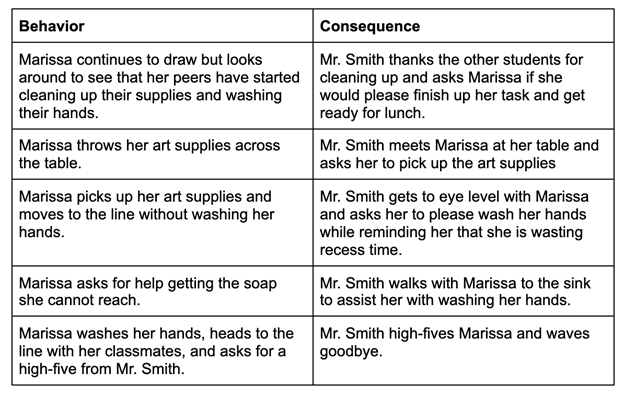March 24, 2022
Student misbehavior in the classroom can be difficult to address. As an educator, you need to determine the cause of the behavior in order to help change it so that all students can be successful.
A functional behavior assessment may be necessary if a student’s challenging behavior interferes with learning, be it for the student exhibiting the behavior or for other students in the learning environment.
Continue reading to determine if a functional behavior assessment is needed for students who display disruptive or problematic behaviors. In this blog, I’ll discuss:
- What a functional behavior assessment is
- The six steps of a functional behavior assessment
- When a functional behavior assessment might be used for an IEP
- And more

What is functional behavior assessment?
A functional behavior assessment (FBA) identifies problem behaviors, and the environmental functions of those behaviors, that interfere with learning in children and provides recommendations to reduce or replace them.
A functional behavior assessment is needed for any challenging behavior, and it is recommended that FBAs be implemented before placing a child into an intervention. An FBA should (a) identify both positive and negative behaviors, and (b) provide a more complete picture of the child. This will allow intervention to be tailored to the student’s unique needs.
During an FBA, you collect granular data when a behavior occurs, such as:
- The time the behavior occurred
- The learning environment involved
- Those who were with the child
- The subject being taught
- The antecedent(s) that led to the behavior
- The function the behavior served (e.g., avoiding group work, etc.)
The data collected from an FBA is what drives the next steps in providing support to the student.

Functional behavior assessment starts with understanding the ABCs
Functional behavior assessments are used to determine the function or purpose of an interfering behavior. During this assessment, the “ABCs” will be examined:
- A (antecedent): What happens directly before the behavior occurs (events, actions, circumstances).
- B (behavior): The behavior that occurs. This should be an observable and measurable act, and the observer should not make a guess about the internal state of the student exhibiting the behavior.
- C (consequence): What happens directly after the behavior (response, action, or event). This may include verbal interactions with peers or staff, physical interactions with peers or staff, and prompting of any type.
Observers may need to collect data over several sessions before they have enough information to see a clear ABC pattern. In addition to taking notes about the events, the observer should also record the setting of the behavior, time of day in which it took place, and the people involved.
Here are three brief examples of ABC data recording:
Example 1:
- Antecedent—The teacher asks Sarah to stop her work on the computer.
- Behavior—Sarah screams “No!” and continues what she is doing.
- Consequence—The teacher repeats her direction for Sarah to leave the computer.
Example 2:
- Antecedent—The teacher calls on Juan to answer a question during a social studies lesson.
- Behavior—Juan sings his answer.
- Consequence—The teacher ignores Juan’s behavior.
Example 3:
- Antecedent—The teacher puts Robert’s book on the desk in front of him.
- Behavior—Robert throws the book on the floor.
- Consequence—The classroom assistant moves Robert to the time-out table, and Robert avoids having to do his reading assignment.
It’s important to examine what happens before and during the behavior, but it’s perhaps even more crucial to look at the consequence part of the data recording. Do the responses lead to an increase or a decrease in problem behavior?
For example, if a child is exhibiting a behavior to get out of completing their work, then isolating them from the rest of the class with nothing to do only reinforces their behavior, and other consequences should be applied instead.
If a student shows a lot of attention-seeking behavior, they should be ignored in certain circumstances and directed on how to get attention in a more positive manner at a different time.
Looking at the patterns of the ABC data collection can help us make better choices when correcting behaviors. Responses should focus on:
- Strengthening the desired behavior
- Suggesting a replacement behavior
- Decreasing the amount of problem behavior

What is included in a functional behavior assessment? The 6-step process
To help determine the function or purpose of an interfering behavior, functional behavior assessments involve six key steps. Let’s examine each step in detail.
Step 1: Collect the data
The first step in a functional behavior assessment is collecting as much data as possible to determine the interfering behavior.
Collecting this information under various conditions can help determine the context of specific behaviors. This information allows educators to get ahead of problem behaviors by predicting when the behavior may occur.
There are two methods that can be used to collect data:
Direct observation
Data collected during a direct observation is done by observing the student in settings or situations in which the challenging behavior typically occurs.
Indirect observation
Indirect observations involve gathering information via interviews with people who know the students well and interact with them regularly.
Information obtained during these interviews should include:
- How often the problem behavior occurs
- How intense the behavior is
- What events might be influencing the behavior
- What events occur immediately before and immediately after the behavior
- The assumed function of the behavior (e.g., Is it attention-seeking behavior?)
Step 2: Analyze the data
Once the data has been collected, an analysis of the indirect data should be done to identify any consistent patterns, common responses, or similar observations.
Next, review all of the direct data as well to identify patterns in:
- How the student responds to antecedents
- How any adults or peers respond to the behavior
- What happens after the behavior
- Consequences of the behavior
Finally, compare the direct data with the indirect data. If the data is in agreement, it may suggest a strong explanation for why the behaviors are happening.
If the observations are not in agreement, both types of observations should continue to be conducted.

Step 3: Develop a hypothesis
To create an effective plan, forming a hypothesis about why a student misbehaves is essential. Developing a hypothesis can be broken down into three parts:
- Function: What is the desired response or activity the student hopes to receive? Is it to get attention?
- Skill deficit: Is the student struggling to perform at the behavioral or academic level expected of them?
- Performance deficit: Does the student know the academic or behavioral skill but chooses not to perform it?
The hypothesis should:
- Identify why the displayed behavior might be occurring
- Define the student’s purpose for displaying said behaviors
- Be used as a guide for creating a behavior support plan
Step 4: Form a behavior support plan
Observers should create a plan that addresses any behaviors identified in the functional behavior assessment process. The plan should include strategies that will:
- Address antecedents of the behavior
- Teach replacement behaviors
- Provide consequences to maintaining the problem behavior
Step 5: Implement a behavioral intervention plan
Implementing an effective behavioral intervention plan involves providing educators and family members with clear information on:
- The one or two target behaviors being addressed
- Strategies that will be used to change the behavior
- When the strategies will be implemented—and who will implement them
- How educators and family members will know if the support plan is working
- A schedule to follow up and evaluate the progress and success of the support plan
Step 6: Evaluate
When evaluating a functional behavior assessment, the evaluator should monitor whether the plan is being followed appropriately and how well it is changing the student’s negative behaviors. Making periodic progress checks is necessary in order to see whether the support plan is making a positive impact.
If the problem behavior is persistent, moving back to the assessment phase may be necessary.
Understanding functional behavior assessment
Discover solutions from Renaissance to support a more effective FBA process.

When is functional behavior assessment necessary?
When a student exhibits behavior that limits or inhibits their ability to learn within the parameters of the classroom or school environment, the assessment is a helpful tool.
As noted earlier, functional behavior assessments should identify both positive and negative behaviors to get a clear picture of the whole child. This can help inform instruction and intervention for the student.
Typically, functional behavior assessments are conducted in response to student behaviors that cause concern among:
- Parents or guardians
- Teachers
- School staff
- Community members
The concern is often that the student may have emotional or behavioral problems—these are behaviors that may interfere with their ability to learn and grow personally.
Functional behavior assessments can be coordinated with other efforts to better understand a student’s situation, including the confirmation of a disability or the development of an Individualized Learning Plan.
When a functional behavior assessment might be used for an IEP
A functional behavior assessment is often conducted as a first step for teachers or practitioners to understand why a learner, including students with autism spectrum disorder (ASD), may be engaging in interfering behaviors. Upon becoming aware of the behavior’s purpose, teachers and practitioners can then develop interventions to reduce its occurrence.
To address these behaviors in learners, teachers and practitioners commonly use:
- Functional communication training: Oftentimes, verbal language can be confusing for students, and this is especially true of learners with ASD. To help communicate, consider using pictures and icons, communication scripts that include visuals, or social stories.
- Differential reinforcement: It is important to be aware when behavior is reinforced and acknowledged. Be strategic when behavior is recognized. For example, positively reinforce only the desired behavior when exhibited by the student and ignore undesired behaviors when exhibited.
- Response interruption/redirection: Students form patterns of behavior. This happens for positive behavior as well as negative behavior. Therefore, when an undesired behavior begins, immediately introduce a prompt or distractor (i.e., redirect the student). This diverts the student’s attention from the negative behavior and limits the “pattern of behavior” for the student. Interrupting the pattern of behavior when undesired behavior is exhibited helps the student form new patterns of positive behavior.
- Extinction: The ultimate goal is to have the negative behavior end and, in turn, have the desired behavior remain. Therefore, take away current reinforcement/consequences (which are typically provided unintentionally) to decrease or eliminate the negative behaviors.
- Stimulus control/environmental modification: Often, environmental stimuli can lead to a pattern of behavior. Assess the learning environment and remove stimuli that lead to negative behavior and introduce stimuli that lead to positive behavior.
What is an example of a functional behavior assessment?
The table below provides a detailed example of how a functional behavior assessment works.
The antecedent: Mr. Smith announces it’s time for the students to clean up their art supplies, wash their hands, and go to lunch. As the school year continues, Mr. Smith notices a trend of behaviors from Marissa.

The hypothesis: Marissa is seeking attention from the teacher.
The plan for Marissa is to help her understand that she can gain positive attention by:
- Encouraging her to explain to Mr. Smith that she likes to finish what she is working on without feeling rushed
- Using a stool to promote independence at the hand-washing sink
- Following directions on the first prompt
Mr. Smith can further support Marissa by:
- Allowing her to be the line leader the next time she finishes her task accordingly
- Positively acknowledging her when she follows directions on the first prompt (and continuing this pattern in the future)
- Ringing a bell for a two-minute warning so she has time to complete her task without feeling rushed

How Renaissance helps educators support the whole child through functional behavior assessment
A data-driven approach to serving the whole child is at the heart of what Renaissance does.
Our solution combines…
- Social-emotional behavior (SEB) screening to identify any SEB skill deficits
- Methods for direct and indirect observations which can be viewed alongside other whole-child data
- Methods to complete FBAs directly within the system
- Methods for educators to generate and monitor interventions that are created from an FBA
- Actionable plans in which progress can be assessed and the next best step can be taken
- Management and collaboration of your multi-tiered system of support (MTSS)
… and places them in educators’ hands.
As a result, educators can:
- Continually monitor learning and growth
- Identify the academic and social-emotional needs of the student; and
- Optimize learning for each student by aligning targeted support.
Learn more
To learn more about how Renaissance can help you support the whole child, connect with an expert today.

